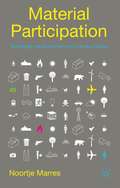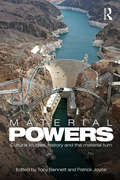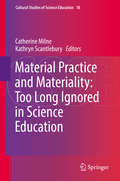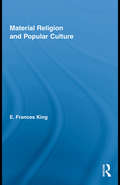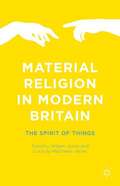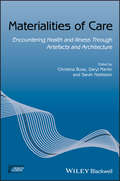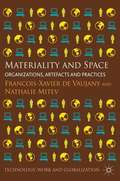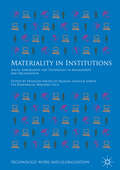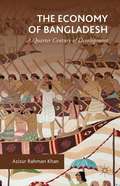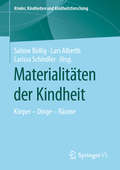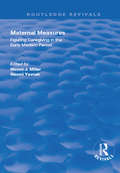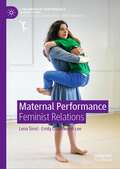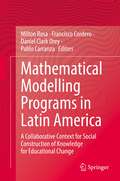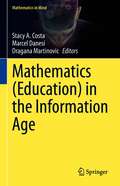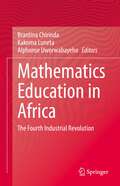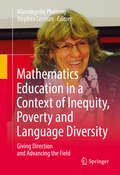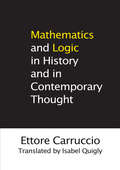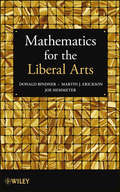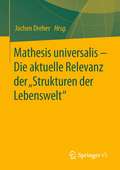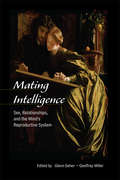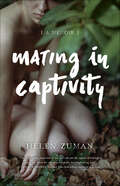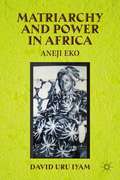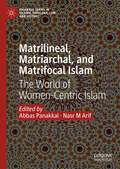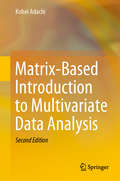- Table View
- List View
Material Participation
by Noortje MarresThis book develops a fresh perspective on everyday forms of engagement, one that foregrounds the role of objects, technologies and settings in democracy. Examining a range of devices, from smart meters to eco-homes, the book sets out new concepts and methods for analyzing the relations between participation, innovation and the environment.
Material Powers: Cultural Studies, History and the Material Turn (CRESC)
by Tony Bennett Patrick JoyceThis edited collection is a major contribution to the current development of a ‘material turn’ in the social sciences and humanities. It does so by exploring new understandings of how power is made up and exercised by examining the role of material infrastructures in the organization of state power and the role of material cultural practices in the organization of colonial forms of governance. A diverse range of historical examples is drawn on in illustrating these concerns – from the role of territorial engineering projects in seventeenth-century France through the development of the postal system in nineteenth-century Britain to the relations between the state and road-building in contemporary Peru, for example. The colonial contexts examined are similarly varied, ranging from the role of photographic practices in the constitution of colonial power in India and the measurement of the bodies of the colonized in French colonial practices to the part played by the relations between museums and expeditions in the organization of Australian forms of colonial rule. These specific concerns are connected to major critical re-examination of the limits of the earlier formulations of cultural materialism and the logic of the ‘cultural turn’. The collection brings together a group of key international scholars whose work has played a leading role in debates in and across the fields of history, visual culture studies, anthropology, geography, cultural studies, museum studies, and literary studies.
Material Practice and Materiality: Too Long Ignored in Science Education (Cultural Studies of Science Education #18)
by Kathryn Scantlebury Catherine MilneIn this book various scholars explore the material in science and science education and its role in scientific practice, such as those practices that are key to the curriculum focuses of science education programs in a number of countries.As a construct, culture can be understood as material and social practice. This definition is useful for informing researchers' nuanced explorations of the nature of science and inclusive decisions about the practice of science education (Sewell, 1999). As fields of material social practice and worlds of meaning, cultures are contradictory, contested, and weakly bounded. The notion of culture as material social practices leads researchers to accept that material practice is as important as conceptual development (social practice).However, in education and science education there is a tendency to ignore material practice and to focus on social practice with language as the arbiter of such social practice. Often material practice, such as those associated with scientific instruments and other apparatus, is ignored with instruments understood as "inscription devices", conduits for language rather than sources of material culture in which scientists share “material other than words” (Baird, 2004, p. 7) when they communicate new knowledge and realities. While we do not ignore the role of language in science, we agree with Barad (2003) that perhaps language has too much power and with that power there seems a concomitant loss of interest in exploring how matter and machines (instruments) contribute to both ontology and epistemology in science and science education.
Material Religion and Popular Culture (Routledge Studies in Religion)
by E. Frances KingIn this study, E. Frances King explores how people first learn to relate to the images and artefacts of religious belief within their domestic environments. As a sense of religious belonging is instilled on a daily basis in the home, it also becomes emotionally linked to family, community, and homeland, resulting in two different genealogies – one to do with faith and one to do with motherland – that become entangled.
Material Religion in Modern Britain
by Timothy Willem Jones Lucinda Matthews-JonesA growing awareness of religious plurality and religious conflict in contemporary society has led to a search for new ways to understand religious change beyond traditional subjects of British ecclesiology. Narratives of the gradual decline of Christianity dominate this field; yet many scholars now concede that Britain's religious landscape was more varied and rich than these narratives would suggest. Material Religion in Modern Britain responds to this challenge by bringing emerging scholarship on material culture to bear on studies of religion and spirituality. The collection is the first to apply this suite of analytical methods to the traditional subjects of British religious studies and the full spectrum of religious denominations, sects, and movements that constituted Britain's multi-faith landscape in the nineteenth and twentieth centuries. The book reveals how, across this religious spectrum, objects were, and continue to be, used in the performance and production of religious faith and subjectivity. In doing so it expands our understanding of the persistence of religious belief and culture in a secularising, secularized, and post-secular society.
Materialities of Care: Encountering Health and Illness Through Artefacts and Architecture (Sociology of Health and Illness Monographs)
by Sarah Nettleton Christina Buse Daryl MartinMaterialities of Care addresses the role of material culture within health and social care encounters, including everyday objects, dress, furniture and architecture. Makes visible the mundane and often unnoticed aspects of material culture and attends to interrelations between materials and care in practice Examines material practice across a range of clinical and non-clinical spaces including hospitals, hospices, care homes, museums, domestic spaces and community spaces such as shops and tenement stairwells Addresses fleeting moments of care, as well as choreographed routines that order bodies and materials Focuses on practice and relations between materials and care as ongoing, emergent and processual International contributions from leading scholars draw attention to methodological approaches for capturing the material and sensory aspects of health and social care encounters
Materiality and Space
by Francois-Xavier de Vaujany Nathalie MitevMateriality and Space focuses on how organizations and managing are bound with the material forms and spaces through which humans act and interact at work. It concentrates on organizational practices and pulls together three separate domainsthat are rarely looked at together: sociomateriality, sociology of space, and social studies of technology. The contributions draw on and combine several of these domains, and propose analyses of spaces and materiality in a range of organizational practices such as collaborative workspaces, media work, urban management, e-learning environments, managerial control, mobile lives, institutional routines and professional identity. Theoretical insights are also developed by Pickering on the material world, Lyytinen on affordance, Lorino on architexture and Introna on sociomaterial assemblages in order to delve further into conceptualizing materiality in organizations. "
Materiality and Time
by Francois-Xavier de Vaujany Nathalie Mitev Pierre Laniray Emmanuelle VaastSociomaterial research overcomes the dichotomy between social and material worlds by concentrating on organizational practices. These practices are constituted by, but also produce, material and social dynamics. This research is currently having an important impact in management studies and adopts a subjective investigation of time to explore materiality and materialization. Studying the institutional evolution of an organization implies long time spans and it is shown more clearly through the inclusion of material traces of past actions. Materiality and Time is split into three parts: Part I explores how time is materialized and performed in organizations, i. e. how artefacts and material space perform time and temporal dynamics in organizations. Part II examines how organizations and organizational members are constituted by and constitutive of material artefacts. Part III reflects on what a historical perspective on these materializations can bring to the study of organizations. Contributions focus on the materialization of time and the material dynamic of organizations.
Materiality in Institutions: Spaces, Embodiment And Technology In Management And Organization (Technology, Work And Globalization Ser.)
by Bernard Leca Eva Boxenbaum François-Xavier de Vaujany Anouck AdrotThis book aims at clarifying the role of materiality, spaces, digitality and embodiment in institutional dynamics from the perspective of Management & Organization Studies. Presenting a rich set of theoretical, methodological and epistemological advances on materiality and institutions, it also gives voice to distinctive and diverse perspectives on materiality in institutions, structuring chapters into four major topics: artefacts and objects, digitality and information, space and time, body and embodiment. This book sparks discussion and debate about ontological dimensions of Management & Organization Studies, including post-discursive, visual, phenomenological and material.
Materiality, Rules and Regulation: New Trends in Management and Organization Studies (Technology, Work and Globalization)
by Nathalie Mitev François-Xavier de Vaujany Anouk Mukherjee Giovan LanzaraMateriality, Rules and Regulation: New Trend in Management and Organization Studies concentrates on the relationship of rules and regulation to the materiality of artefacts, practices, and organizations. It combines the recent scholarly interest on sociomateriality with a focus on regulation and rules.
Materialitäten der Kindheit: Körper – Dinge – Räume (Kinder, Kindheiten und Kindheitsforschung #22)
by Larissa Schindler Lars Alberth Sabine BolligDer Band fasst aktuelle Theorieperspektiven und Forschungsbefunde zur Bedeutung von Körpern, Objekten und Räumen in der interdisziplinären Kindheitsforschung zusammen. Es wird gezeigt, in welchem Maße diese Materialitäten daran mitwirken, dass sich bestimmte gesellschaftliche Kindheitsmuster und -erfahrungen ausbilden und wie material die Positionierungs- und Subjektivierungsprozesse von Kindern als Kinder gedacht werden müssen.
Maternal Measures: Figuring Caregiving in the Early Modern Period
by Naomi J. Miller and Naomi YavnehThis title was first published in 2000: Care-givers in the early modern period included not only mothers and stepmothers, but also midwives and nurses, tutors and educators, wise women and witches. The contributors to this volume present research and criticism on a wide range of early modern care-giving roles by women in England, Italy, Spain, France, Latin America, Mexico and the New World. The essays are not only cross-cultural but also interdisciplinary, spanning literature, history, music and art history; and they focus on differences of gender, class and race. A wide variety of scholarly and critical approaches are represented. Essays are grouped in categories on conception and lactation; maternal nurture and instruction; domestic production; and social authority.
Maternal Performance: Feminist Relations (Contemporary Performance InterActions)
by Lena Šimić Emily Underwood-LeeMaternal Performance: Feminist Relations bridges the fields of performance, feminism, maternal studies, and ethics. It loosely follows the life course with chapters on maternal loss, pregnancy, birth, aftermath, maintenance, generations, and futures. Performance and the maternal have an affinity as both are lived through the body of the mother/artist, are played out in real time, and are concerned with creating ethical relationships with an other – be that other the child, the theatrical audience, or our wider communities. The authors contend that maternal performance takes the largely hidden, private and domestic work of mothering and makes it worthy of consideration and contemplation within the public sphere.
Mathematical Modelling Programs in Latin America: A Collaborative Context for Social Construction of Knowledge for Educational Change
by Milton Rosa Daniel Clark Orey Francisco Cordero Pablo CarranzaThis book is about the unique, sophisticated, and rigorous study of mathematics in Latin America developed over centuries of cultural exchange between Europe, North, and South America. More specifically, the book explores the tradition of mathematical modelling, introduced a century ago. This modelling was adapted to assist members of distinct communities to draw information about their own realities through the elaboration of representations, which generate mathematical knowledge that deals with creativity and invention. The book provides empirical evidence that a category of mathematical modelling developed in Latin America assesses the horizontal and reciprocal relations between mathematics (school/non-school contexts) and the real world. These relations provide an epistemological and ontological change, where mathematical knowledge of the others is recognized on a horizontal plane. Further, they oblige mathematics teachers and students to understand as a community of knowledge that builds their own mathematical categories of their environment governed by the reciprocal relationships between academic knowledge and functional knowledge. The dimensions of the relationships make up a frame of reference that guides educational change in mathematics. The book presents an inquiry-based approach of three Latin American modelling programs: ethnomodelling, transversality of knowledge, and reasoned decision-making. Each one, with its respective theoretical and methodological foundations related to ethnomathematics and mathematical modelling, socioepistemology, and the attribution of meaning to learning. Undoubtedly, the three mathematical modelling programs, independently, provide educational gains, each with its levels of specificity and loyal to its philosophical, theoretical, and methodological principles. However, the book places them together, organized by axes, to define a corpus of mathematical knowledge that envisions profound educational change through the development of different approaches of mathematical modelling. The authors of the 18 chapters in this book, who represent the diversity of Latin America, are from eight countries: Argentina, Brazil, Chile, Colombia, Costa Rica, Cuba, Ecuador, Honduras, and Mexico. They were invited to share their ideas, perspectives, and discuss investigations that represent a rich sample of three Latin American perspectives on mathematical modelling.
Mathematics (Mathematics in Mind)
by Marcel Danesi Dragana Martinovic Stacy A. CostaThis book brings together ideas from experts in cognitive science, mathematics, and mathematics education to discuss these issues and to present research on how mathematics and its learning and teaching are evolving in the Information Age. Given the ever-broadening trends in Artificial Intelligence and the processing of information generally, the aim is to assess their implications for how math is evolving and how math should now be taught to a generation that has been reared in the Information Age. It will also look at the ever-spreading assumption that human intelligence may not be unique—an idea that dovetails with current philosophies of mind such as posthumanism and transhumanism. The role of technology in human evolution has become critical in the contemporary world. Therefore, a subgoal of this book is to illuminate how humans now use their sophisticated technologies to chart cognitive and social progress. Given the interdisciplinary nature of the chapters, this will be of interest to all kinds of readers, from mathematicians themselves working increasingly with computer scientists, to cognitive scientists who carry out research on mathematics cognition and teachers of mathematics in a classroom.
Mathematics Education in Africa: The Fourth Industrial Revolution
by Kakoma Luneta Brantina Chirinda Alphonse UworwabayehoThis book is about mathematics teaching and learning in Africa during the Fourth Industrial Revolution. The Fourth Industrial Revolution (4IR) has evolved to utilize new technologies in the teaching and learning of Mathematics. It is characterized by the fusion of the biological, physical and digital worlds and embodies a new era of innovation in mathematics education, leading to the rapid emergence of new technologies for mathematics teaching and learning. Because 4IR in mathematics education is happening differently in various parts of Africa, the authors of the various chapters in this volume have positioned their work in their respective local contexts. The chapters address a wide variety of interests, concerns, and implications regarding 4IR and Mathematics Education in Africa. Additionally, a number of chapters address teaching mathematics in the context of the COVID-19 pandemic that has gripped the world. Other chapters discuss the implications of inequalities in Africa that effect mathematics education during 4IR. Chapters also incorporate arguments, observations, and suggestions to, improve and transform the teaching and learning of mathematics in Africa during the 4IR.This book highlights a new era of innovation in mathematics education in the context of the Fourth Industrial Revolution, leading to the rapid emergence of new technologies in mathematics teaching and learning. It is a valuable resource for graduate students, people with research interests in the fourth industrial revolution and mathematics educators at any level, including all mathematics teachers; mathematics education curriculum designers and policymakers.
Mathematics Education in a Context of Inequity, Poverty and Language Diversity
by Mamokgethi Phakeng Stephen LermanThis volume is dedicated to the career of Jill Adler and the role she has played in growing mathematics education research in South Africa, Africa and beyond. Her work epitomises what is referred to as the 'engaged scholar': i. e. doing rigorous and theoretically rich research at the cutting edge of international work in the field which at the same time contributes to critical areas of local and regional need in education. Jill is one of the world's leading experts in mathematics education research and her exemplary career is a continuous source of inspiration for generations of researchers and students. The chapters in this volume are authored by Jill's former PhD students, a few select colleagues from different parts of the world that she collaborated with as well as leading scholars who she worked with in PME, ICMI and in her many international assignments. In essence, this volume celebrates Jill's contribution not only to mathematics education but also to our contributions as her friends and colleagues. Topics covered include language and mathematics, teacher education, and the dilemma of an activist researcher engaging in issues that matter hugely to the participants in the research, students and teachers in post-apartheid schooling, whilst also setting up the separation that is needed for good research.
Mathematics and Logic in History and in Contemporary Thought
by Isabel Quigly Ettore CarruccioThis book is not a conventional history of mathematics as such, a museum of documents and scientific curiosities. Instead, it identifies this vital science with the thought of those who constructed it and in its relation to the changing cultural context in which it evolved. Particular emphasis is placed on the philosophic and logical systems, from Aristotle onward, that provide the basis for the fusion of mathematics and logic in contemporary thought.
Mathematics for the Liberal Arts
by Martin J. Erickson Donald Bindner Joe HemmeterPresents a clear bridge between mathematics and the liberal arts Mathematics for the Liberal Arts provides a comprehensible and precise introduction to modern mathematics intertwined with the history of mathematical discoveries. The book discusses mathematical ideas in the context of the unfolding story of human thought and highlights the application of mathematics in everyday life. Divided into two parts, Mathematics for the Liberal Arts first traces the history of mathematics from the ancient world to the Middle Ages, then moves on to the Renaissance and finishes with the development of modern mathematics. In the second part, the book explores major topics of calculus and number theory, including problem-solving techniques and real-world applications. This book emphasizes learning through doing, presents a practical approach, and features: A detailed explanation of why mathematical principles are true and how the mathematical processes work Numerous figures and diagrams as well as hundreds of worked examples and exercises, aiding readers to further visualize the presented concepts Various real-world practical applications of mathematics, including error-correcting codes and the space shuttle program Vignette biographies of renowned mathematicians Appendices with solutions to selected exercises and suggestions for further reading Mathematics for the Liberal Arts is an excellent introduction to the history and concepts of mathematics for undergraduate liberal arts students and readers in non-scientific fields wishing to gain a better understanding of mathematics and mathematical problem-solving skills.
Mathesis universalis – Die aktuelle Relevanz der „Strukturen der Lebenswelt“
by Jochen DreherDie Beiträge des Bandes setzen sich mit den „Strukturen der Lebenswelt“ als Analyseinstrument für phänomenologisch-sozialwissenschaftliche Forschungen auseinander. Zum einen werden die „Strukturen der Lebenswelt“ insbesondere Thomas Luckmann zufolge in Anlehnung an Edmund Husserl als mathesis universalis verstanden, die eine elementare Struktur allen menschlichen Verhaltens darstellt und somit als tertium comparationis für die empirische, sozio-historisch ausgerichtete Sozialforschung dient. Die phänomenologische Beschreibung der Lebenswelt muss als „Protosoziologie“ verstanden werden, die das Problem der Vergleichbarkeit historischer Daten löst. Phänomenologie und Soziologie gleichen in diesem Sinne in einer „Parallelaktion“ ihre Erkenntnisse ab, indem die erkenntnistheoretische phänomenologische Fundierung die soziologische empirische Rekonstruktion absichert. Zum anderen wird im Anschluss an Schütz/Luckmann vor allem im US-amerikanischen Kontext die Variante einer „phänomenologischen Soziologie“ vorgeschlagen, die auf das Verstehen, Beschreiben und Analysieren der Lebenswelt abzielt, so wie sie von denjenigen erfahren wird, die in ihr leben. In einer Abgrenzung vom Positivismus und Behaviorismus wird die Suspension der natürlichen Einstellung, die Aufdeckung verdeckter Hintergrundannahmen eingefordert und zum Sehen-der-Phänomene-wie-sie-sind – etwa im Sinne von Harold Garfinkels Ethnomethodologie – aufgerufen.
Mating Intelligence: Sex, Relationships, and the Mind's Reproductive System
by Geoffrey Miller Glenn GeherHuman intelligence is sexually attractive, and strongly predicts the success of sexual relationships, but the behavioral sciences have usually ignored the interface between intelligence and mating. This is the first serious scholarly effort to explore that interface, by examining both universal and individual differences in human mating intelligenc
Mating in Captivity: A Memoir
by Helen ZumanWhen recent Harvard grad Helen Zuman moved to Zendik Farm in 1999, she was thrilled to discover that the Zendiks used go-betweens to arrange sexual assignations, or “dates,” in cozy shacks just big enough for a double bed and a nightstand. Here, it seemed, she could learn an honest version of the mating dance—and form a union free of “Deathculture” lies. No one spoke the truth: Arol, the Farm’s matriarch, crushed any love that threatened her hold on her followers’ hearts. An intimate look at a transformative cult journey, Mating in Captivity shows how stories can trap us and free us, how miracles rise out of crisis, how coercion feeds on forsaken self-trust.
Matriarchy and Power in Africa
by David Uru IyamAneji Eko was technically illiterate, but she represents a resource for understanding the complexities of African and Nigerian cultures. This is an account of matriarchy and the complex ties of kinship, their influences in shaping childhood culture, and how they determined cultural expectations across ethnic groups.
Matrilineal, Matriarchal, and Matrifocal Islam: The World of Women-Centric Islam (Palgrave Series in Islamic Theology, Law, and History)
by Nasr M Arif Abbas PanakkalAround the world, Islamic cultures have developed distinctive matrilineal, matrifocal, matrilocal, or matriarchal natures as a result of how they have been practised by integrated and indigenised Muslim communities. In matrilineal descent systems, in contrast to the more common mosaic of patrilineal patterns, children belong to the mother’s ancestry group. Matrilineal Muslims therefore follow a social system in which people are identified with their mother's lineage, and the inheritance of property as well as succession are transferred through the matriline. This volume focuses on matrilineal, matrifocal and matriarchal Muslims and their unique folk natures, integrated social structures, adopted legal systems, and so on. It provides a unique perspective for understanding global Muslim communities that have succeeded in integrating the matrilineal tenets of local practices with religion, adhering to essential Islamic values in a way that makes traditional women-centred cultures acceptable to mainstream Islam.
Matrix-Based Introduction to Multivariate Data Analysis
by Kohei AdachiThis is the first textbook that allows readers who may be unfamiliar with matrices to understand a variety of multivariate analysis procedures in matrix forms. By explaining which models underlie particular procedures and what objective function is optimized to fit the model to the data, it enables readers to rapidly comprehend multivariate data analysis. Arranged so that readers can intuitively grasp the purposes for which multivariate analysis procedures are used, the book also offers clear explanations of those purposes, with numerical examples preceding the mathematical descriptions.Supporting the modern matrix formulations by highlighting singular value decomposition among theorems in matrix algebra, this book is useful for undergraduate students who have already learned introductory statistics, as well as for graduate students and researchers who are not familiar with matrix-intensive formulations of multivariate data analysis.The book begins by explaining fundamental matrix operations and the matrix expressions of elementary statistics. Then, it offers an introduction to popular multivariate procedures, with each chapter featuring increasing advanced levels of matrix algebra. Further the book includes in six chapters on advanced procedures, covering advanced matrix operations and recently proposed multivariate procedures, such as sparse estimation, together with a clear explication of the differences between principal components and factor analyses solutions. In a nutshell, this book allows readers to gain an understanding of the latest developments in multivariate data science.
